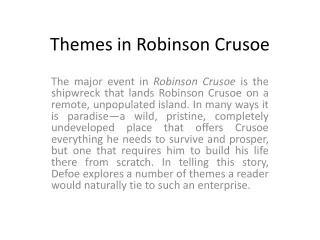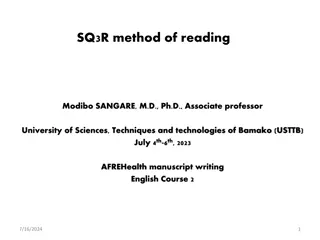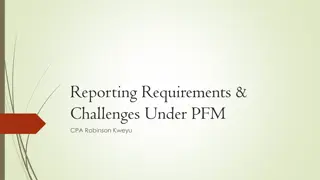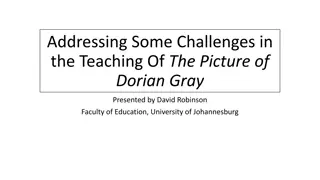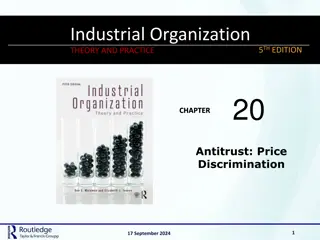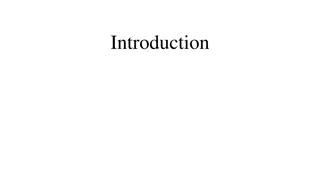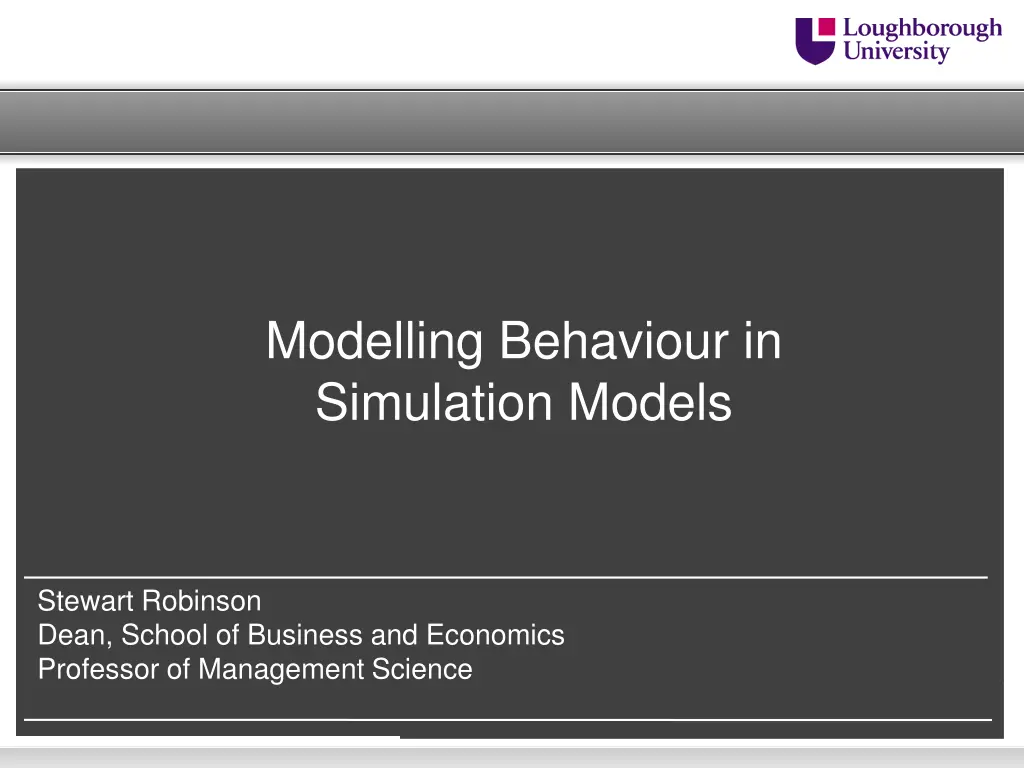
Modelling Behaviour in Simulation Models with Examples
Explore the application of modelling behaviour in simulation models through examples like the Lorry Loading Bay Problem, Knowledge Based Improvement, Agent-Based Modelling, and the Newsvendor Problem. Understand decision-making scenarios, predictive performance strategies, and knowledge-based improvements in operational systems.
Download Presentation

Please find below an Image/Link to download the presentation.
The content on the website is provided AS IS for your information and personal use only. It may not be sold, licensed, or shared on other websites without obtaining consent from the author. If you encounter any issues during the download, it is possible that the publisher has removed the file from their server.
You are allowed to download the files provided on this website for personal or commercial use, subject to the condition that they are used lawfully. All files are the property of their respective owners.
The content on the website is provided AS IS for your information and personal use only. It may not be sold, licensed, or shared on other websites without obtaining consent from the author.
E N D
Presentation Transcript
Modelling Behaviour in Simulation Models Stewart Robinson Dean, School of Business and Economics Professor of Management Science
Outline Four examples: A Lorry Loading Bay Problem Knowledge Based Improvement (KBI): Ford Engine Plant Agent-Based Modelling (ABS): the Axelrod Cultural Model ABS and KBI: the Newsvendor Problem
Modelling Behaviour Part I: 1995 A Lorry Loading Bay Problem Lorry park Bay 1 Bay 2 Bay 3 Bay 4 Capacity 10 Capacity 20 Capacity 20 Capacity 10
Modelling Behaviour Part I: 1995 A Lorry Loading Bay Problem: Decision tree derived from example cases using a simulation model Lorry Size Outcome <11 Lane1 = 0 Lane1 > 0 1 4 >= 11 Lane2 = 0 Lane3 = 0 Lane3 > 0 2 3 0
Modelling Behaviour Part II: Knowledge Based Improvement (KBI) Investigation of the operations system Stage 1 Understanding the process and the decision- making required Generate decision- making scenarios VIS model Elicit knowledge Predict performance of decision-making strategies Stage 4 Stage 2 Decisions taken under scenarios (data sets held for each decision-maker) Provide input to the VIS in place of the decision-makers Data sets Stage 3 Stage 5 Seek improvements Trains AI model Represent the decision-making strategy of each decision-maker
Modelling Behaviour Part II: Knowledge Based Improvement (KBI)
Modelling Behaviour Part II: Knowledge Based Improvement (KBI)
Modelling Behaviour Part II: Knowledge Based Improvement (KBI) Subject A Subject B 100% 100% 80% 80% 60% 60% 40% 40% 20% 20% 0% 0% 2D 3D VR Real-world 2D 3D VR Real-world Visual display vs real-world Visual display vs real-world Subject C Entry point for untested engines from Assy line B Exit point for empty plattens UV booth 100% Platten wash Exit point for tested engines 9 11 13 15 17 19 Path control switch Repair station A1 Test cell 80% 3/4 5/6 A2: For rejected engines and empty plattens required by repair loop A3: For relooped or repaired engines Entry point for rejects from UV J B Waiting stand Sensor2 60% A4 A5 Entry point for empty plattens and rejects from ATD 40% A6: For relooped engines or empty plattens Cell control switch for cell 17/19 9/11 13/15 A7: For empty plattens C D 20% Sensor1 Tilting table 7/8 10/12 14/16 18/20 1/2 0% F 2D 3D VR Real-world E Visual display vs real-world 1 2 3 4 5 6 7 8 10 12 14 16 18 20
Modelling Behaviour Part III: Agent Based Modelling Axelrod Culture Model: Diffusion of Ideas 1 2 3 4 5 6 7 8 9 10 1 1_CDD 2_CDD 3_CDD 4_CDD 5_EBA 6_CDD 7_CDD 8_CDD 9_CDD 10_CDD 2 11_CDD 12_CDD 13_CDD 14_CDD 15_EBA 16_CDD 17_CDD 18_CDD 19_FEE 20_CDD 3 21_CDD 22_CDD 23_CDD 24_EBA 25_EBA 26_CDD 27_CDD 28_CDD 29_FEE 30_CDD 4 5 31_CDD 32_CDD 33_CDD 34_CDD 35_EBA 36_AFC 37_AFC 38_CDD 39_FEE 40_FEE 41_CDD 42_CDD 43_CDD 44_CDD 45_CDD 46_CDD 47_AFC 48_AFC 49_FEE 50_FEE 6 51_CDD 52_CDD 53_CDD 54_CDD 55_CDD 56_CDD 57_AFC 58_AFC 59_FEE 60_CDD 7 61_CDD 62_CDD 63_CDD 64_CDD 65_CDD 66_CDD 67_CDD 68_AFC 69_CDD 70_CDD 8 71_CDD 72_CDD 73_CDD 74_CDD 75_CDD 76_CDD 77_CDD 78_CDD 79_CDD 80_CDD 9 81_CDD 82_CDD 83_CDD 84_CDD 85_CDD 86_CDD 87_CDD 88_CDD 89_CDD 90_CDD 91_CDD 92_CDD 93_CDD 94_CDD 95_CDD 96_CDD 97_CDD 98_CDD 99_CDD 100_CDD 10
Modelling Behaviour Part IV: KBI and Agent Based Modelling Agent Based Simulation of Supply Chains: Newsvendor Problem D w Supplier Retailer Market demand q Min{q,D} w(q) p Material Funds Information
Modelling Behaviour Part IV: KBI and Agent Based Modelling Adapted KBI approach Stage 1 Stage 4 Understand the decision-making process Key Run the ABS model outcomes Simulation games ABS model Decision models Stage 2 Stage 3 Conduct the gaming sessions Fit the decision- making strategies Data sets
Modelling Behaviour Part IV: KBI and Agent Based Modelling Examples of supplier decisions 250 200 Wholesale price 150 100 50 0 1 6 11 16 21 26 31 36 41 46 Period w(t) w*
Modelling Behaviour Part IV: KBI and Agent Based Modelling Examples of retailer decisions 350 300 250 Order quantity 200 150 100 50 0 1 6 11 16 21 26 31 36 41 46 Period q(t) d(t-1) q*
Modelling Behaviour Part IV: KBI and Agent Based Modelling Fitting (behavioural) regression models = + + + i i i i ( ) ( 1) ( 1) ( 1) w t w t q t P t Suppliers s i 0 w q P SUP1: w(t)1 = 115.85 + 0.506w(t-1) - 0.014q(t-1) Adj. R2 = 0.852 Retailers = + + + + j j j j j ( ) ( ) ( 1) ( 1) ( 1) q t w t q t d t P t o w q d P r j RET1: q(t)1 = 246.81- 0.945w(t) - 0.033q(t-1) 0.045d(t-1) Adj. R2 = 0.867
Modelling Behaviour Part IV: KBI and Agent Based Modelling Supplier Retailer Agent Based Model Set price w Waiting for price Determine order quantity q Waiting for order Deliver order q Waiting for delivery t+1 t+1 Satisfy customer demand Min (q, d) Waiting for payment Receive payment from retailer w. q Receive payment from customer p. Min (q, d)
Modelling Behaviour Part IV: KBI and Agent Based Modelling Efficiency scores F1 RET1 RET2 RET3 RET4 RETOPT F2 0.150 (0.001) 0.527 (0.006) 0.397 (0.003) 0.375 (0.003) 0.320 (0.001) SUP1 [ 0.000] [ 0.002] [ 0.001] [ 0.001] [ 0.000] 0.434 (0.002) 0.778 (0.008) 0.636 (0.005) 0.461 (0.005) 0.644 (0.005) SUP2 [ 0.001] [ 0.002] [ 0.001] [ 0.001] [ 0.001] 0.708 (0.005) 0.968 (0.012) 0.851 (0.009) 0.585 (0.008) 0.849 (0.008) SUP3 [ 0.001] [ 0.003] [ 0.002] [ 0.002] [ 0.002] 0.550 (0.003) 0.878 (0.010) 0.734 (0.007) 0.507 (0.006) 0.741 (0.006) SUPOPT [ 0.001] [ 0.003] [ 0.002] [ 0.002] [ 0.002]

